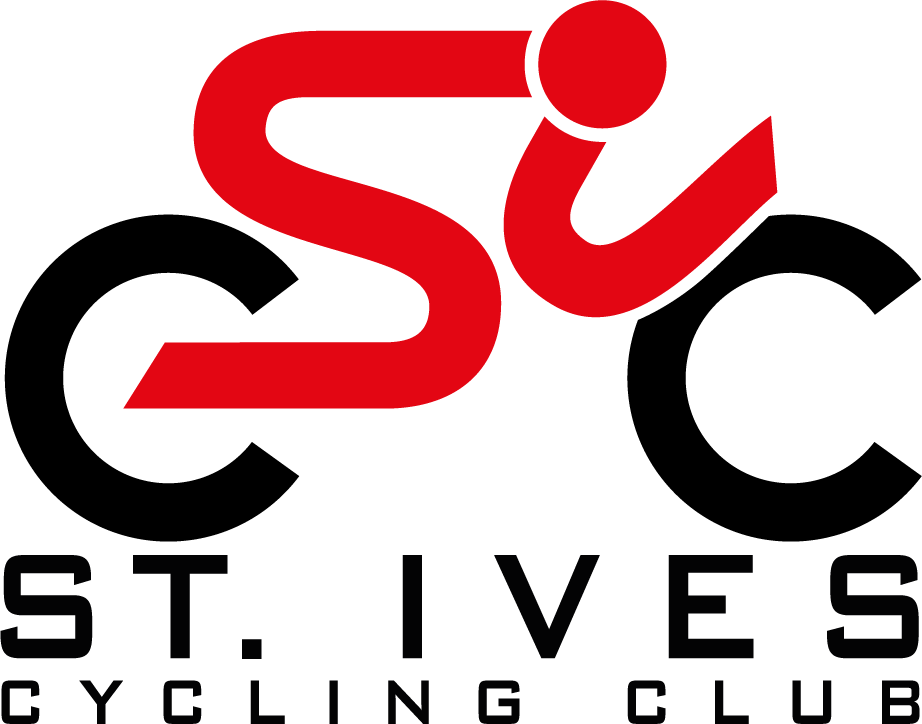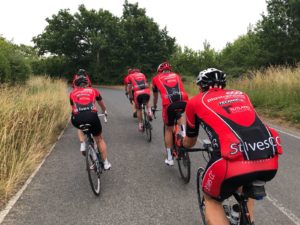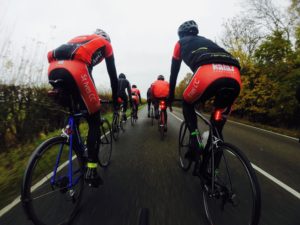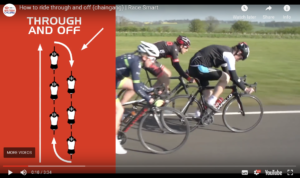The following advice applies to all club group rides, and is recommended practice for any groups riding together on the road based on advice from British Cycling and the rules of the Highway Code.
Equipment
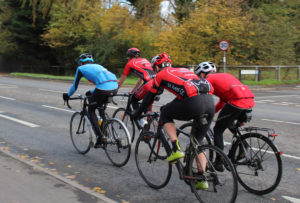 Helmets should be worn by all riders on group rides. Tri-bars/aero-bars should not be used, and riders should keep their hands on the handlebars at all times. The ‘descending on the top tube’ position is generally considered unsafe and should not be used on group rides.
Helmets should be worn by all riders on group rides. Tri-bars/aero-bars should not be used, and riders should keep their hands on the handlebars at all times. The ‘descending on the top tube’ position is generally considered unsafe and should not be used on group rides.
Riders should come to group rides equipped with suitable clothing (for the forecasted conditions plus allowance for it to be colder and/or wetter than forecasted) and nutrition (enough to be self-sufficient for the expected duration of the ride). Their bicycle should be in good working order and well-maintained, with working brakes, tyres pumped to a suitable pressure and drivetrain lubricated. They should also carry a tool kit with at least a spare inner tube, pump and basic tools, as well as a phone and some money.
Groups should ride safely and use the correct equipment.
Group size
The optimal group size is roughly 6-12 riders. When a group is too large, the difficulties of communication, maintaining a steady pace, crossing road junctions and allowing vehicles to pass become magnified. Motorists find large group of cyclists problematic and annoying, often misjudging when overtaking the group and cutting in dangerously. Groups above the recommended size should split into smaller sub-groups.
Groups above the recommended size should split into two smaller groups.
Group formation
Riders should cycle side-by-side in pairs with each rider directly behind the rider in front of them. If riders ride to one side of the rider in front of them, this causes the group to spread across the road, taking up more space than is necessary. It also makes the group appear to be more than two abreast, especially to a driver waiting behind. The Highway Code (Rule 66) states that cyclists should ride no more than two abreast and should ride in single file on narrow or busy roads.
NEVER overlap your front wheel with the back wheel of the rider in front. Anticipate and moderate your speed to achieve this without the need for sudden braking. Maintain a distance to the rider in front that you feel comfortable with (roughly 0.5-1 metres), and increase this distance in more dangerous conditions such as on wet roads or when descending.
More information on group riding is shown in this British Cycling video.
Groups should ride in pairs, with each rider in line with the rider in front.
Singling out
Singling out is used on narrow or busy roads, or when there are obstructions such as a row of parked cars. If a group member calls “Single out!”, riders on the inside should accelerate to allow riders on the outside to slip in behind them in turn.
Groups should single out on narrow or busy roads, or when negotiating obstructions.
Road junctions
Take care at road junctions. Calls of “Clear!” or “Car left/right!” help riders behind, but each rider should make their own decision on whether it is safe for them to cross the junction. Groups waiting at a junction should remain in pairs and avoid bunching up. Members of the group who have crossed the junction should be aware that other riders may have had to wait and need time to rejoin. Always obey traffic lights and signs (Highway Code rules 69 and 71).
Take care at junctions. Each member of the group is individually responsible for his or her own safety. Always obey the Highway Code.
Other road users
Riders should have consideration for other road users at all times. When approaching a horse and rider, the group should slow down, call out to make sure the horse rider knows they are there, and pass wide and slow (Highway Code rules 214 and 215). Let pedestrians know that you are there when necessary, especially when riding on shared use paths when you need to give way to them if necessary.
Always ride with consideration for other road users.
Group behaviour
The club run is a social event and is NOT a race. Care must be taken that the pace of the group is within the capability of the slowest rider within that group. If a rider gets dropped, for example on a hill, the group should wait for them and make sure they are ok before continuing. A rider who is struggling can choose to slow down and wait for a slower group coming along behind, but this should ALWAYS be by agreement and not by default. Conversely, riders should make sure the group they are joining will be riding at a speed they are comfortable with (the club ride groups have guide speeds).
Riders SHOULD NOT ‘half wheel’: when riding beside another rider, keep your pace the same as theirs, rather than gradually increasing your pace. ‘Half wheeling’ is very bad group riding etiquette.
An important group riding skill is watching/understanding the riders around you. Who is comfortable with the pace, and who is finding it more difficult? Is the rider who is supposed to be directly behind you struggling to hold your wheel? A group ride is teamwork!
Always behave predictably while riding in a group. Avoid sudden turns and braking and warn other people of what you are going to do.
If a rider has a mechanical or other issue, the group should stop and help to fix it. Never leave people behind!
Always take care of the other riders in your group.
Taking turns at the front
All members of the group should take a turn at the front, which helps particularly when the group is riding into a strong wind. There are two ways to rotate the turns at the front:
For a normal paired group ride, the rider on the outside at the front lets the others know he is about to change, then accelerates and moves over in front of the nearside rider ‘goes through’, before easing back to the group pace. The outside riders then move up to form new pairs, and the last rider on the inside moves to the outside to reform into pairs (if there is an odd number of riders, there will be a single rider at the back who can either be on the inside or outside). The group remains in this formation until the next change, which may be for several minutes (the time is determined by the rider at the front on the outside who can extend their ‘turn’ if they are strong, or cut this short otherwise).
When riding ‘Through and off’ the rotation is continuous, with the one line of riders (usually the one on the outside) moving faster than the other. The rider at the back of the slower line accelerates as the last rider in the faster line passes, joining the back of the faster line and moving forward with it. When reaching the front of the faster line, the rider moves across smoothly (without accelerating further) to the front of the slower line and then soft pedals or coasts to slow to the pace of the slower line. ‘Through and off’ is used by faster groups and/or when in a strong wind. Usually the faster line is on the outside, but if there is a cross/headwind from the right the rotation can be reversed so that the slower line is in the wind. See the British Cycling video for more information.
If a rider is struggling, they may elect to ‘miss a turn’ and remain at the back of the group until they have recovered. They should let the other riders know this to avoid confusion.
Groups should rotate turns at the front using one of the above procedures.
Communication within the group
It is important that information is passed quickly and clearly to all members of the group. Some shouts and signals are standard:
- “Left/right turn” accompanied by the left/right turn signal indicates to the rest of the group, and to other road users, that the group is about to turn left/right.
- “Car front” warns that a vehicle of any type is approaching the front of the group.
- “Car back” warns that a vehicle of any type is approaching the rear of the group.
- “On the left” accompanied by putting the left arm up behind the back, warns following riders that there is an obstruction, such as a parked car or pedestrians, on the near side of the road
- “Hole left/right” accompanied by pointing to the road with the appropriate hand is a warning that there is some hazard in the road. This may be a pothole, drain cover, branch, brick, horse droppings, etc.
- “Easy” is a request to slow down and be careful, for example if there is a hazard ahead (horses, a loose dog, walkers etc.), the group is approaching a junction, there is a problem in the group such as a mechanical, or if the group is breaking up because the speed is too high.
- “Stopping” indicates that the group is about to stop, because of a junction, puncture etc. The group should avoid sudden braking and should not spread across the road.
It is very important that shouts and signals are passed on through the group, to ensure the safety of all riders.
